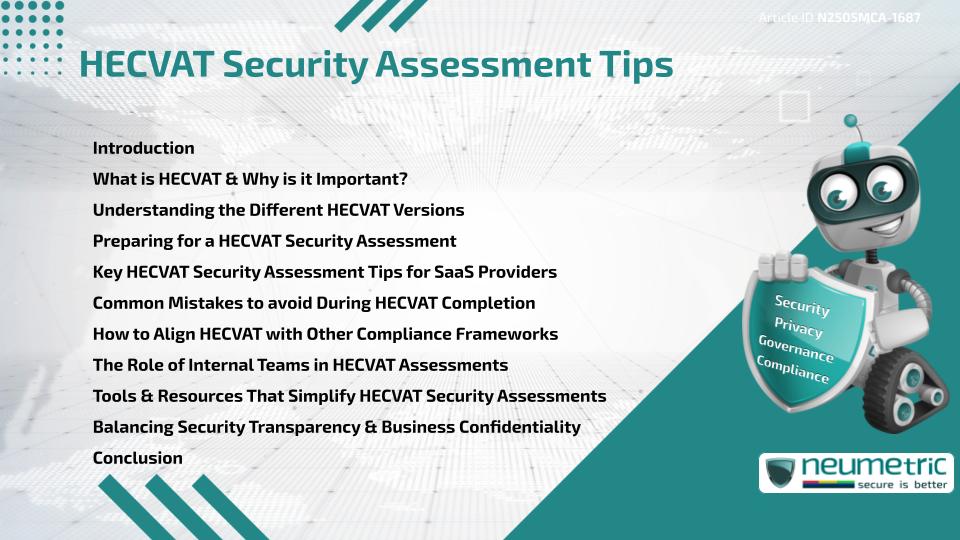Table of Contents
ToggleIntroduction
The Higher Education Community Vendor Assessment Tool [HECVAT] was created to address growing Cybersecurity concerns among colleges & universities. Vendors who want to serve educational institutions must prove they meet specific Security Standards. This is where the right HECVAT security assessment tips become essential. Whether you are a Software-as-a-Service [SaaS] provider or a Cloud Service Vendor, understanding how to complete the HECVAT effectively can boost your credibility, reduce onboarding delays & build trust with institutional clients.
In this article, we explore the purpose of HECVAT, offer practical guidance on how to approach the assessment process & share valuable tips to help Vendors meet the expectations of higher education buyers.
What is HECVAT & Why is it Important?
HECVAT is a Standardised Questionnaire developed by the higher education community to evaluate Third Party Vendors’ Information Security & Data Protection practices. It is designed to ensure that Vendors meet the Risk Management Standards required to safeguard Student Data, Research Assets & Institutional Networks.
Unlike traditional Audits, HECVAT helps educational institutions streamline Vendor Assessments without starting from scratch every time. For Vendors, this means one well-prepared response can serve many potential clients.
EDUCAUSE provides official HECVAT versions & ongoing updates to the Framework.
Understanding the Different HECVAT Versions
There are three main versions of HECVAT:
- HECVAT Full – A comprehensive version for Vendors with critical services or Sensitive Data handling.
- HECVAT Lite – A shorter version suitable for low-Risk services.
- HECVAT On-Premise – For Vendors offering on-site installations or devices.
Knowing which version to complete is one of the simplest but most overlooked HECVAT security assessment tips. Many Vendors waste time answering unnecessary questions. Clarify your service Risk level with your prospective institution before starting the process.
Preparing for a HECVAT Security Assessment
Preparation is key to submitting a successful HECVAT. Start by identifying the right contacts within your Organisation. This typically includes your Information Security Lead, Compliance Officer & System Architects.
Next, gather the documentation that supports your security claims. This includes:
- Network Diagrams
- Data Flow Charts
- Access Control Policies
- Encryption Standards
- Incident Response Plans
Make sure all documents are updated & easy to reference.
Key HECVAT Security Assessment Tips for SaaS Providers
For SaaS Vendors, here are essential HECVAT security assessment tips:
- Answer precisely, not broadly: Avoid generic language. Tailor answers to each control item.
- Support your claims: Whenever possible, provide references to Policies or tools.
- Use consistent language: Review your terminology. For example, say “Multi-factor authentication” instead of “2FA” if the latter isn’t clearly defined.
- Provide evidence of regular reviews: HECVAT values ongoing Risk Management, not just one-time setups.
- Check for logical inconsistencies: Answers in one section may contradict another if multiple people contribute.
Common Mistakes to avoid During HECVAT Completion
Even experienced Vendors make simple mistakes that delay approval. Here are a few pitfalls:
- Overlooking ‘Not Applicable’ questions: Mark these properly & briefly explain why they don’t apply.
- Leaving blanks: Empty answers signal incomplete understanding.
- Failing to update outdated responses: A response from last year may not reflect today’s setup.
- Using vague responses: Avoid phrases like “we follow Best Practices” without examples.
Avoiding these errors will significantly increase your approval possibilities. A useful resource to cross-check common errors is the HECVAT Wiki.
How to Align HECVAT with Other Compliance Frameworks
If you are already following Standards like ISO 27001, SOC 2 or NIST 800-53, you can align those with your HECVAT responses. Doing so can reduce duplication & show maturity in your security posture.
For instance, if you’re certified under ISO 27001, map your controls to the relevant HECVAT questions. This also demonstrates Audit Readiness & consistent Governance.
The Role of Internal Teams in HECVAT Assessments
Successful HECVAT completion depends on internal collaboration. Your legal, IT & security teams should work together, not in silos.
- Legal team: Clarifies data sharing, Privacy terms & breach notification obligations.
- IT team: Offers network architecture & systems information.
- Security team: Addresses Risk Mitigation, monitoring & Incident Response.
Keep communication open & assign clear responsibilities early in the process.
Tools & Resources That Simplify HECVAT Security Assessments
Several tools can make HECVAT easier:
- Cloud Security Alliance’s CAIQ as a cross-reference
- Documentation Management Platforms to track evidence
- Template trackers to monitor completion progress
Automating repetitive parts of the assessment helps reduce human error & speeds up the process.
Balancing Security Transparency & Business Confidentiality
One overlooked part of HECVAT completion is managing what to disclose. While transparency is valued, Vendors must also protect proprietary processes.
You can achieve this by:
- Redacting sensitive diagrams
- Providing general architectural overviews
- Including non-disclosure disclaimers in your submission
This balance ensures Compliance without overexposing internal operations.
Conclusion
HECVAT has become a base pillar in the Cybersecurity Assessment for higher education institutions. For Vendors, especially in the SaaS & Cloud Service sectors, knowing how to navigate this assessment can make the difference between winning or losing a contract. By following practical HECVAT security assessment tips—like choosing the right version, answering with clarity, aligning with existing Compliance efforts & collaborating across teams—you not only meet institutional expectations but also demonstrate your commitment to safeguarding Sensitive Data.
Approaching HECVAT with preparation, precision & transparency will help build stronger relationships with educational clients & open the door to long-term partnerships built on trust & accountability.
Takeaways
- HECVAT is an important tool for Vendors planning to enter higher education markets.
- Choosing the right version of the form saves time & effort.
- Detailed, honest & supported answers build trust.
- Avoiding vague language & errors improves credibility.
- Collaboration & good documentation are the backbone of success.
FAQ
What is the purpose of HECVAT?
HECVAT helps educational institutions assess the security Risks of Third Party Vendors by using a Standardised questionnaire.
Who should fill out the HECVAT questionnaire?
Vendors providing cloud or on-premise services to higher education institutions should complete the appropriate HECVAT version.
How long does it take to complete a HECVAT?
Depending on your preparation & version type, it can take from one (1) to two (2) weeks to complete.
Can I reuse HECVAT responses for multiple clients?
Yes, if you keep your responses current & relevant, they can be reused with minimal updates.
Do I need to be SOC 2 compliant to complete HECVAT?
No, but having SOC 2 Compliance can help you map & justify your HECVAT responses.
What’s the difference between HECVAT Full & HECVAT Lite?
HECVAT Full is for high-Risk services while HECVAT Lite is for low-Risk or minimal data handling services.
Is HECVAT only for cloud Vendors?
No, there’s also a HECVAT On-Premise version for Vendors who provide physical or local installations.
What should I do if I don’t understand a HECVAT question?
You should consult your internal security team or reach out to the requesting institution for clarification.
References
- HECVAT Wiki & Support Guide
- Cloud Security Alliance: CAIQ Questionnaire
Need help?
Neumetric provides organisations the necessary help to achieve their CyberSecurity, Compliance, Governance, Privacy, Certifications & Pentesting goals.
Organisations & Businesses, specifically those which provide SaaS & AI Solutions, usually need a CyberSecurity Partner for meeting & maintaining the ongoing Security & Privacy needs & requirements of their Clients & Customers.
SOC 2, ISO 27001, ISO 42001, NIST, HIPAA, HECVAT, EU GDPR are some of the Frameworks that are served by Fusion – a centralised, automated, AI-enabled SaaS Solution created & managed by Neumetric.
Reach out to us!


